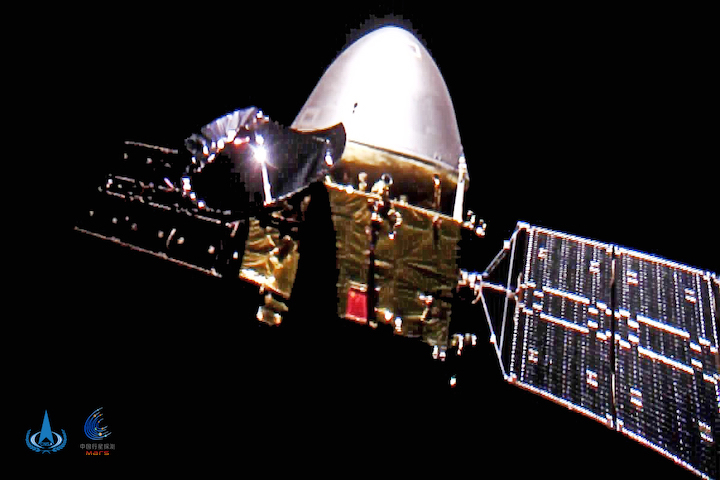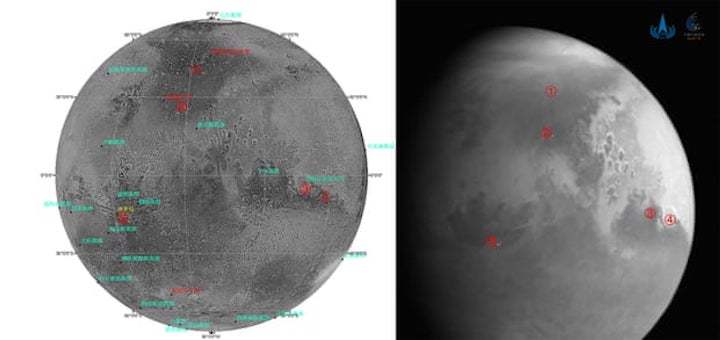China’s Tianwen-1 probe has sent back its first picture of Mars, the Chinese space agency has said, as the mission prepares to touch down later this year.
The spacecraft, launched in July around the same time as a US mission, is expected to enter Mars orbit around 10 February.
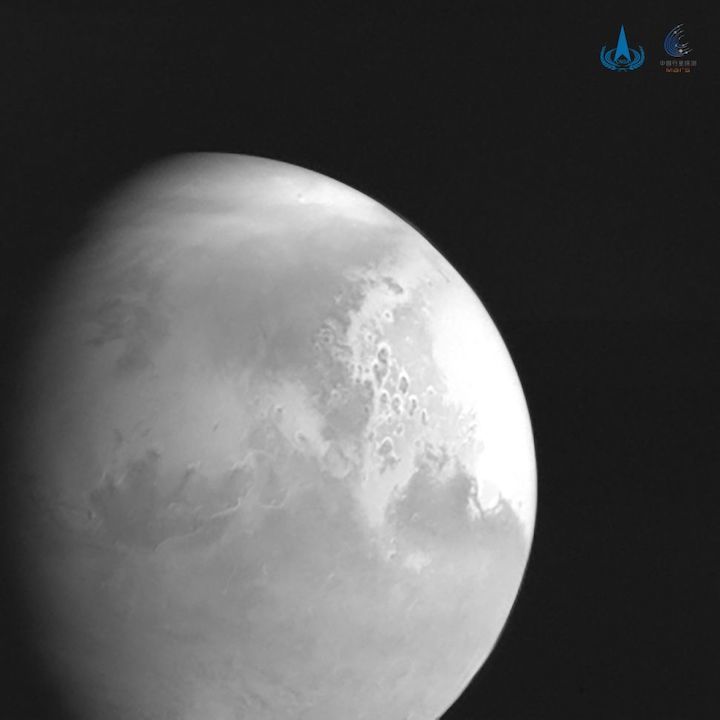
The photo released by the China National Space Administration shows geological features including the Schiaparelli crater and the Valles Marineris, a vast stretch of canyons on the Martian surface.
The photo was taken from about 1.4m miles away (2.2m kilometres), said the CNSA, with the spacecraft since reaching 1.1 million kilometres from the planet.
The robotic craft ignited one of its engines to make an orbital correction on Friday and was expected to slow down before being captured by Martian gravity around 10 February, the agency said.
The five-tonne Tianwen-1 includes a Mars orbiter, lander, and a rover that will study the planet’s soil.
China hopes to land the rover in May in Utopia, a massive impact basin.
China has poured billions of dollars into its military-led space programme and first sent a human into space in 2003. It is aiming to assemble a space station in Earth orbit by 2022.
Mars has always been challenging target, with most missions sent by the US, Russia, Europe, Japan and India since 1960 ending in failure.
Tianwen-1 is not China’s first attempt to reach Mars. A previous mission with Russia in 2011 ended prematurely as the launch failed.
China has sent two rovers to the moon – one of them becoming the first to make a successful soft landing on the far side.
Quelle: TheGuardian
+++
China's Mars probe completes fourth orbital correction
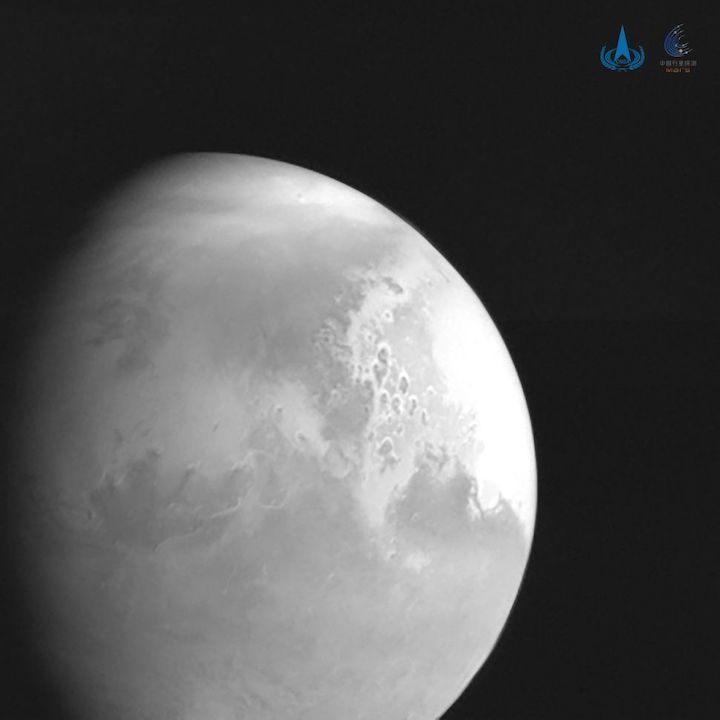
Photo released by the China National Space Administration (CNSA) shows the first image of Mars captured by Mars probe Tianwen-1 from a distance of 2.2 million km. China's Mars probe Tianwen-1 conducted its fourth orbital correction Friday night, according to the CNSA. The probe carried out the orbital correction at 8 p.m. (Beijing time), aiming to ensure that the probe achieves a sound planned rendezvous with Mars. The CNSA also said the probe had captured the first image of Mars from a distance of 2.2 million km. The probe has traveled about 197 days in orbit, flying about 465 million km. It is currently 184 million km from Earth and 1.1 million km from Mars. All probe systems are in good working condition, the CNSA said. (Xinhua)
China's Mars probe Tianwen-1 conducted its fourth orbital correction Friday night, according to the China National Space Administration (CNSA).
The probe carried out the orbital correction at 8 p.m. (Beijing time), aiming to ensure that the probe achieves a sound planned rendezvous with Mars.
The CNSA also said the probe had captured the first image of Mars from a distance of 2.2 million km.
Launched on July 23, 2020, the probe completed its first orbital correction on Aug. 2, its second on Sept. 20 and its third on Oct. 28.
The probe has traveled about 197 days in orbit, flying about 465 million km. It is currently 184 million km from Earth and 1.1 million km from Mars. All probe systems are in good working condition, the CNSA said. Enditem
Quelle: Xinhua
----
Update: 10.02.2021
.
China’s Mars Mission Begins Orbit of the Red Planet
The Tianwen-1 mission is the second of three new visitors to Mars this month.
China has landed on the moon three times, and even managed to bring one of its robotic lunar explorers back to Earth. Can it now pull off the challenge of landing on Mars?
The country’s space agency completed a key step toward that goal on Wednesday when Tianwen-1, the spacecraft the country launched last July, began its orbit of the red planet, according to state media reports. By accomplishing this feat, China completed its first successful journey to another planet in our solar system.
The spacecraft was also the second to arrive at Mars in two days, following a United Arab Emirates probe that began orbiting the neighboring world on Tuesday.
China is expected try to place a lander and a robotic rover on the planet later this year. It would join what could by then be a trio of NASA spacecraft studying the Martian surface.
The Tianwen-1 Spacecraft
China’s mission to Mars features a probe that will land on the planet with help from a parachute.
Lander
A parachute attached to a protective SHELL will slow the lander’s descent. Next, a set of STRUTS will deploy midair. Once on the surface, a RAMPwill slide out so the rover can drive off.
Orbiter
After the orbiter reaches Mars, the landing probe will detach and descend to the planet’s surface.
Rover
Four solar panel wings will unfurl after landing.
Tianwen-1 left Earth last summer, taking advantage of a period when Mars and Earth were closest to each other during their journeys around the sun. That allowed a relatively short transit between the two worlds.
To catch up with Mars, the spacecraft fired its engines on several occasions, correcting its course so it could approach the red planet at the correct angle. After the most recent engine firing on Feb. 5, the probe sent back pictures of the red planet from a distance of about 1.3 million miles.
On Wednesday at 7:52 p.m. in Beijing (6:52 a.m. Eastern time), the engine lit up again for 15 minutes, expending much of the spacecraft’s remaining fuel in a braking maneuver. That slowed it considerably, and allowed the probe to be captured by Martian gravity into an elliptical orbit. It will now circle at a safe distance, joining the cast of other robotic explorers in Martian orbit as it prepares for that later surface landing attempt.
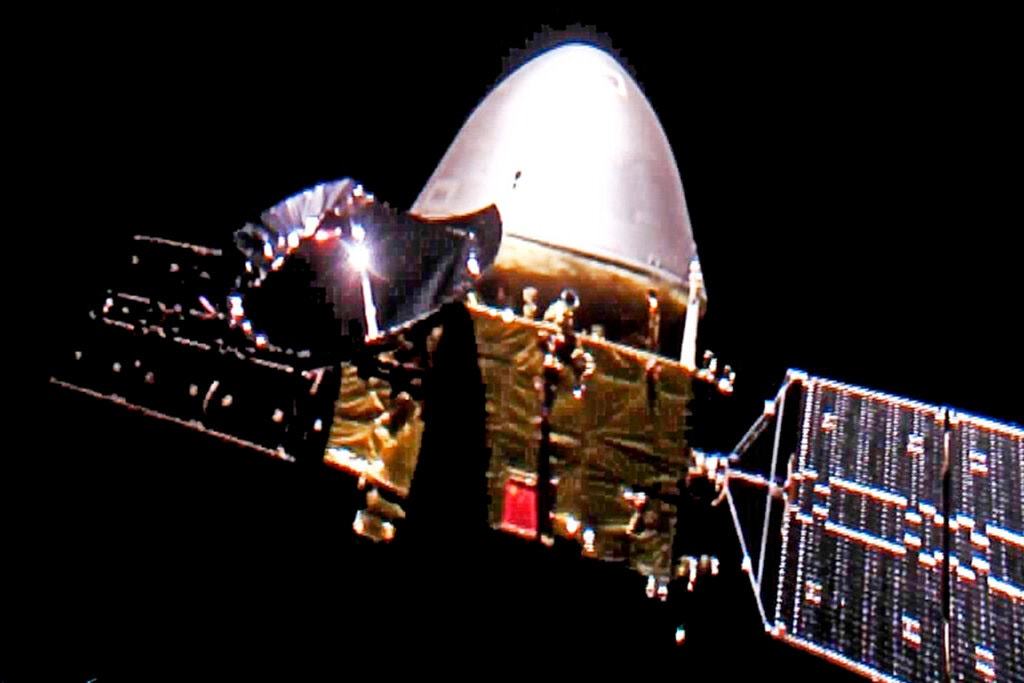
The Tianwen-1 probe en route to Mars in an image released in December.Credit...CNSA
In arriving at Mars, China far surpassed its last attempt at an interplanetary mission, which failed nearly 10 years ago, although through no fault of the country’s own. That Mars-bound spacecraft, Yinghuo-1, burned up in Earth’s atmosphere when the Russian rocket it was traveling on failed in flight.
But while the arrival at Mars was a new milestone for China’s space program, a bigger challenge for the Tianwen-1 mission is a few months away.
When will China land on Mars?
The orbiter carries a lander and a rover which will make the difficult transit to the surface. China says it will attempt to land on Mars as early as May, but it has not specified a date.
Its destination is Utopia Planitia, a large basin in the northern hemisphere that most likely was once impacted by a meteor, and which was visited by NASA’s Viking 2 lander in 1976. One goal of the Tianwen-1 mission is to better understand the distribution of ice in this region, which future human colonists on Mars could use to sustain themselves.
Landing on the red planet is perilous. Spacecraft descend at a high speed and the thin atmosphere does little to help slow the trip to the ground. Air friction still generates extreme heat that must be absorbed or dissipated. A number of Soviet, NASA and European missions have crashed. Only NASA has landed intact more than once.
The Chinese spacecraft will spend months orbiting Mars to check systems and pick a landing spot that will not be too treacherous.
Should it land in one piece, the rover will need a name. After nominations from people in China, a panel of experts selected 10 semifinalists. Among them, according to state media, are Hongyi, from a Chinese word for ambition and persistence; Qilin, a hoofed creature of Chinese legend; and Nezha, a young deity who is considered a patron of rebellious youth.
What else has China accomplished in space recently?
Since China launched its mission to Mars in July, it has been to the moon and back.
The Chang’e-5 mission lifted off in November, collected lunar samples and then brought them back to Earth for scientists to study. It was the first new cache of moon rocks since the Soviet Union’s last lunar mission in 1976.
China’s Chang’e-4 mission, the first to land on the moon’s far side, is still in operation and its Yutu-2 rover is still studying the lunar surface more than two years after it launched.
What else is arriving at the red planet in 2021?
The first robotic probe to arrive at Mars this year was Hope, an orbiter from the United Arab Emirates’ emerging space agency. It arrived on Tuesday, and will embark on a study of the red planet’s atmosphere, helping planetary scientists understand the weather dynamics of Mars.
The third new visitor to Mars will be Perseverance, NASA’s newest rover. It launched a bit later than the other two spacecraft last July, and will skip Martian orbit, heading directly to the planet’s surface on Feb. 18.
The robotic explorer would be NASA’s fifth rover on Mars, and it is very similar to Curiosity, which is now exploring the Gale crater. The new rover carries a different set of scientific instruments and will explore the Jezero crater, a dried-out lake that scientists believe could be a good target to seek fossilized evidence of extinct Martian microbial life.
The mission will also attempt a new first on the red planet: flying a helicopter in the wispy Martian atmosphere. NASA’s Ingenuity helicopter will be dropped off by the rover not long after landing. Then it will attempt a number of test flights in air as thin as the upper reaches of Earth’s atmosphere, aiming to demonstrate that Mars can be explored through the air as well as on the ground.
What other spacecraft are currently studying Mars?
It’s getting a bit crowded around the red planet.
In addition to the new arrivals, six more orbiters are currently studying the planet from space. Three were sent there by NASA: Mars Odyssey, launched in 2001, Mars Reconnaissance Orbiter, launched in 2005, and MAVEN, which left Earth in 2013.
Europe has two spacecraft in orbit. Its Mars Express orbiter was launched in 2003, and the ExoMars Trace Gas Orbiter lifted off in 2016 and is shared with Russia’s space program.
India operates the sixth spacecraft, the Mars Orbiter Mission, also known as Mangalyaan, which launched in 2013.
Two American missions are currently operating on the ground. Curiosity has been roving since 2012. It is joined by InSight, which has been studying marsquakes and other inner properties of the red planet since 2018. A third American mission, the Opportunity rover, expired in 2019 when a dust storm caused it to lose power.
Chinese spacecraft enters Mars' orbit, joining Arab ship
China says its Tianwen-1 spacecraft has entered orbit around Mars on a mission to land a rover and collect data on underground water and possible signs of ancient life
BEIJING -- A Chinese spacecraft went into orbit around Mars on Wednesday on an expedition to land a rover on the surface and scout for signs of ancient life, authorities announced in a landmark step in the country's most ambitious deep-space mission yet.
The arrival of Tianwen-1 after a journey of seven months and nearly 300 million miles (475 million kilometers) is part of an unusual burst of activity at Mars: A spacecraft from the United Arab Emirates swung into orbit around the red planet on Tuesday, and a U.S. rover is set to arrive next week.
China's space agency said the five-ton combination orbiter and rover fired its engine to reduce its speed, allowing it to be captured by Mars' gravity.
“Entering orbit has been successful ... making it our country’s first artificial Mars satellite,” the agency announced.
The mission is bold even for a space program that has racked up a steady stream of achievements and brought prestige to China's ruling Communist Party.
If all goes as planned, the rover will separate from the spacecraft in a few months and touch down safely on Mars, making China only the second nation to pull off such a feat. The rover, a solar-powered vehicle about the size of a golf cart, will collect data on underground water and look for evidence that the planet may have once harbored microscopic life.
Tianwen, the title of an ancient poem, means “Quest for Heavenly Truth.”
Landing a spacecraft on Mars is notoriously difficult. Smashed Russian and European spacecraft litter the landscape along with a failed U.S. lander. About a dozen orbiters missed the mark. In 2011, a Mars-bound Chinese orbiter that was part of a Russian mission didn’t make it out of Earth orbit.
Only the U.S. has successfully touched down on Mars — eight times, beginning with two Viking missions in the 1970s. An American lander and rover are in operation today.
China’s attempt will involve a parachute, rocket firings and airbags. Its proposed landing site is a vast, rock-strewn plain called Utopia Planitia, where the U.S. Viking 2 lander touched down in 1976.
Before the arrival this week of the Chinese spacecraft and the UAE’s orbiter, six other spacecraft were already operating around Mars: three U.S., two European and one Indian.
All three of the latest missions were launched in July to take advantage of the close alignment between Earth and Mars that happens only once every two years.
A NASA rover called Perseverance is aiming for a Feb. 18 landing. It, too, will search for signs of ancient microscopic life, collecting rocks that will be returned to Earth in about a decade.
China’s secretive, military-linked space program has racked up a series of achievements. In December, it brought moon rocks back to Earth for the first time since the 1970s. China was also the first country to land a spacecraft on the little-explored far side of the moon in 2019.
China is also building a permanent space station and planning a crewed lunar mission and a possible permanent research base on the moon, though no dates have yet been proposed.
While most contacts with NASA are blocked by Congress and China is not a participant in the International Space Station, it has increasingly cooperated with the European Space Agency and countries such as Argentina, France and Austria. Early on, China cooperated with the Soviet Union and then Russia.
Quelle: abcNews
+++
China Mars mission: Tianwen-1 spacecraft enters into orbit
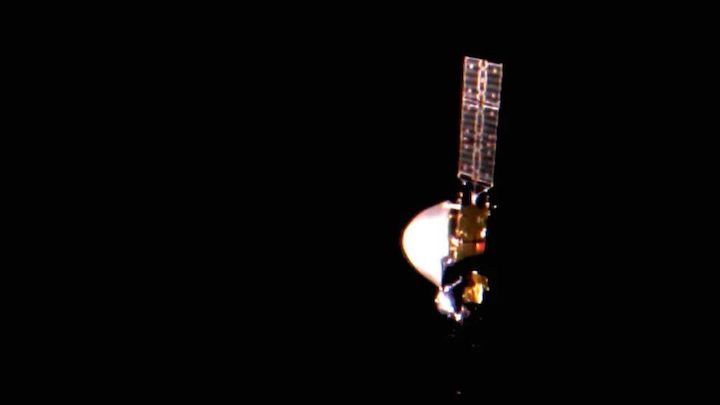
China says it has successfully put its Tianwen-1 mission in orbit around Mars.
It's the first time the country has managed to get a spacecraft to the Red Planet and comes a day after the United Arab Emirates accomplished the same feat.
Tianwen-1, or "Questions to Heaven", comprises an orbiter and a rover.
Engineers will bide their time before despatching the wheeled robot to the surface but the expectation is that this will happen in May or June.
Wednesday's orbit insertion underlines again the rapid progress China's space programme is making.
It follows December's impressive mission to retrieve rock and soil samples from Earth's Moon - by any measure a very complex undertaking.
Tianwen-1's mission, particularly the surface element, will be no less challenging.
Its five-tonne spacecraft stack, made up of orbiter and rover, was launched from Wenchang spaceport in July, and travelled nearly half a billion km to rendezvous with the Red Planet.
Engineers had planned a 14-minute braking burn on the orbiter's 3,000-newton thruster, with the expectation that this would reduce its 23km/s velocity sufficiently to allow capture by Mars' gravity.
The manoeuvre was automated; it had to be. Radio commands currently take 11 minutes to traverse the 190 million km now separating Earth from Mars.
It should have put Tianwen-1 in an initial large ellipse that comes in as close as 400km from the surface and out as far as 180,000km.
This will be trimmed over time to become tighter and more circularised.
In contrast to the Emiratis' live TV coverage on Tuesday, China chose to report the orbit insertion at Mars only after it had occurred.
It was clear early on, however, that events were proceeding as they should because amateur radio enthusiasts could listen across Tianwen-1's signals, and they could see each milestone in the manoeuvre was being achieved.
China is following the strategy employed by the Americans for their successful Viking landers in the mid-1970s. The idea then was to make orbit first and only later send a robot to the surface.
A period of reconnaissance will now follow but Tianwen-1's primary choice for a touchdown is a flat plain within the Utopia impact basin just north of Mars' equator.
The rover, which has yet to be named, looks a lot like the US space agency's (Nasa) Spirit and Opportunity rovers from the 2000s. It weighs some 240kg and is powered by fold-out solar panels.
A tall mast carries cameras to take pictures and aid navigation; five additional instruments will help assess the mineralogy of local rocks and look for any water-ice.
A key experiment will be the ground-penetrating radar, which should be able to sense geological layers at depths of many metres.
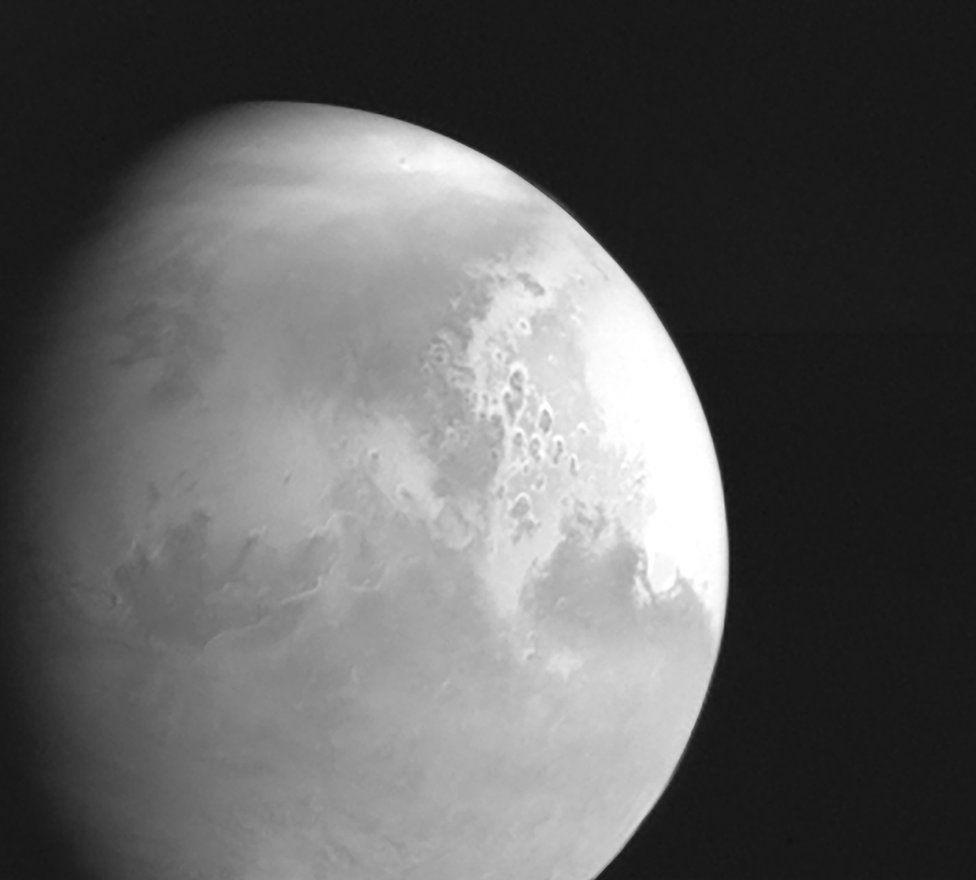 IMAGE COPYRIGHTCNSA
IMAGE COPYRIGHTCNSAThis surface investigation is really only half the mission, however, because the orbiter that has been shepherding the rover will also study the planet, using a suite of seven remote-sensing instruments.
Like previous satellites, this spacecraft will observe characteristics of the high atmosphere and examine the structures and composition of the surface. High- and medium-resolution cameras should return some impressive pictures.
Tinawen-1 is one of three missions arriving at Mars this February.
The UAE's Hope probe made it safely into orbit on Tuesday. Next week, Nasa will attempt to put another of its big rovers on the surface.
Quelle: BBC
----
Update: 13.02.2021
.
China's Tianwen-1 Mars probe captures epic video of Red Planet during orbital arrival
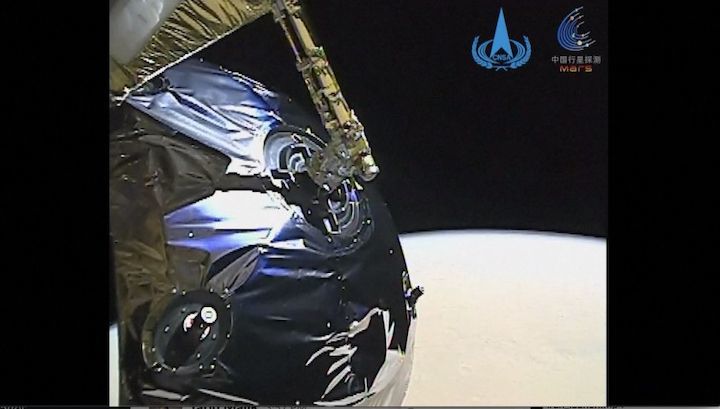
China's Tianwen-1 Mars orbiter captured this view of the Red Planet as it entered orbit around the planet on Feb. 10, 2021. (Image credit: CCTV/CNSA)
China has released epic video footage from the country's Tianwen-1 spacecraft as it made a close approach to Mars after reaching the Red Planet this week.
Tianwen-1 arrived at Mars on Wednesday (Feb. 10) and fired its engines to allow it to enter orbit around the planet. China has now received and put together a series of images taken during this approach and created two remarkable scenes, seen here in a single video.
One video, taken by Tianwen-1's small engineering survey sub-system camera for monitoring a solar array, shows Mars entering into frame followed by an incredible view of the edge of Mars' atmosphere, or "atmospheric limb."
Craters are also visible on the planet's surface, while the solar panel appears to oscillate with the spacecraft firing its main engines to decelerate.
A second video is from the point of view of a monitoring camera for Tianwen-1's tracking antenna, providing similarly amazing footage.
The engineering survey sub-system consists of a number of small monitoring cameras used to monitor processes such as the deployment of solar arrays and other events, according to the China National Space Administration.
The cameras took photos once every three seconds and continuously photographed for around half an hour. The videos have a frame rate of about 10 pictures per second.
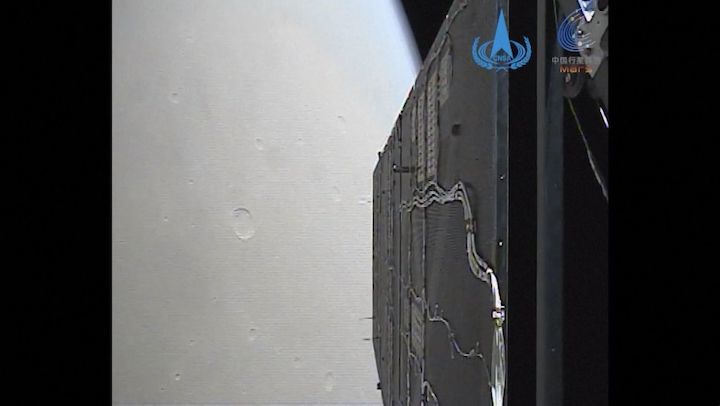
Another Mars view from China's Tianwen-1 orbiter taken as it entered orbit around the planet on Feb. 10, 2021. (Image credit: CCTV/CNSA
Tianwen-1, which means "Questioning the Heavens," launched on July 23, 2020 and is China’s first independent interplanetary mission. It arrived in orbit around Mars after a 202-day, 295-million-mile (475 million kilometers) journey through deep space. It snapped an image of the Red Planet during its final approach.
The spacecraft consists of both an orbiter and a rover. The landing attempt for the rover is not expected until May or June, giving the orbiter time to image and map out the intended landing site in a region known as Utopia Planitia.
Tianwen-1's roughly 530-lb. (240 kilograms) solar-powered rover carries science payloads to investigate surface soil characteristics and search for potential water-ice distribution with a ground penetrating radar. The rover also carries a panoramic camera similar to one aboard China's Yutu 2 rover, which is currently exploring the the far side of Earth's moon.
The Tianwen-1 orbiter will study the Red Planet's surface with medium- and high-resolution cameras and a sounding radar, and make other detections with a magnetometer and particle detectors.
Quelle: SC
+++
China releases video of Tianwen-1's entry into Mars orbit
The China National Space Administration (CNSA) on Friday released a video showing how Mars probe Tianwen-1 braked to allow its capture by the red planet's gravity.
China's Tianwen-1 probe, including an orbiter, a lander and a rover, successfully entered the orbit around Mars on Wednesday after a nearly seven-month voyage from Earth.
The video fully recorded Mars gradually entering the field of view, the slight vibration of the probe after the engine was ignited, and the probe's flight from Mars day to Mars night. The solar wing, directional antenna, Martian atmosphere, and surface morphology are visible in the video.
The CNSA said that Tianwen-1 sends blessings from distant Mars on the occasion of Chinese Lunar New Year.
According to the CNSA, the video was made from the fast playback of still images at a rate of 10 frames per second. The images were taken by surveillance cameras on the solar wing and directional antenna. The cameras took images every three seconds for about 30 minutes.
Tianwen-1 has a monitoring system consisting of multiple small cameras with low energy consumption. The cameras, installed on solar wings, directional antennas, and the lander-rover combination, can automatically take deep-space selfies, as well as images of the deployment of antennas and solar wings, and of key maneuvering processes, without ground command control.
The CNSA said the cameras would continue monitoring and recording Tianwen-1's exploration of Mars. Enditem
Quelle: Xinhua
+++
China's Tianwen-1 to perform orbital maneuvers ahead of Mars landing
China's Tianwen-1 probe will make several orbital maneuvers to prepare for its landing attempt on Mars, which is due to take place in the coming months, Chinese scientists said in a recent interview with Science and Technology Daily.
Experts from the China Academy of Space Technology said that the craft, which entered orbit around Mars on Wednesday, will brake to adjust the orbital inclination of the flight at the apoareion, the highest point of the orbit around Mars.
Tianwen-1 will then brake at the periareion, the point in the orbit that is closest to Mars, and adjust its orbital period to ensure that the spacecraft's track passes the preset landing site.
When the Chinese probe reaches the periareion for the second time, it will brake again to perform an orbital maneuver and make sure the lander and rover of Tianwen-1 can complete the landing on Mars at the scheduled time and place.
Finally, Tianwen-1 will decelerate again and take pictures of the landing area. It will select the optimal point in the orbit to make the lander-rover combination separate from the orbiter and enter the Martian atmosphere.
China's Tianwen-1 probe, including an orbiter, a lander and a rover, successfully entered the orbit around Mars on Wednesday after a nearly seven-month voyage from Earth.
During the Earth-Mars transfer orbit, Tianwen-1's flight was mostly unpowered. The probe was affected by the deviation of orbit entry and other factors. It had four orbital corrections to make it stay in the preset orbit.
It is expected to land on Mars in May or June. Chinese space engineers and scientists have chosen a relatively flat region in the southern part of the Utopia Planitia, a large plain, as the potential landing zone. A rover will be released after the landing to conduct scientific exploration. Enditem
Quelle: Xinhua
----
Update: 16.02.2021
.
China's Tianwen-1 probe performs orbital adjustment around Mars
China's Tianwen-1 probe on Monday performed an orbital maneuver around Mars after it became the country's first spacecraft to explore an extraterrestrial planet.
A 3000N engine was ignited at 5 p.m. (Beijing time) to ensure the probe's trajectory passes the poles of Mars. The periareion, the point in the orbit that is closest to Mars, was adjusted to 265 km, according to the China National Space Administration (CNSA).
The spacecraft will perform several more orbital adjustments to enter a parking orbit, said the CNSA.
The probe, including an orbiter, a lander and a rover, successfully entered the Mars orbit on Feb. 10 after a nearly seven-month voyage from Earth.
The lander carrying the rover is expected to land on Mars in May or June. Chinese space engineers and scientists have chosen a relatively flat region in the southern part of Utopia Planitia, a large plain, as a potential landing zone. The rover will be released after landing to conduct scientific exploration. Enditem
Quelle: Xinhua
----
Update: 25.02.2021
.
China's Tianwen-1 enters Mars parking orbit
China's Tianwen-1 probe on Wednesday entered the parking orbit of Mars after performing an orbital maneuver, according to the China National Space Administration (CNSA).
At 6:29 a.m. (Beijing Time), Tianwen-1 entered the parking orbit, with its closest point to the planet at 280 km and the farthest point at 59,000 km. It will take Tianwen-1 about two Martian days to complete a circle (a Martian day is approximately 40 minutes longer than a day on Earth), the CNSA said.
Tianwen-1, including an orbiter, a lander and a rover, will run in the orbit for about three months.
The CNSA added that payloads on the orbiter will all be switched on for scientific exploration. The medium-resolution camera, high-resolution camera and spectrometer will carry out a detailed investigation on the topography and dusty weather of the pre-selected landing area in preparation for a landing.
On July 23, 2020, Tianwen-1 was launched from the Wenchang Spacecraft Launch Site in southern China's island province of Hainan.
The probe has been traveling in space for 215 days and is currently about 212 million km from Earth. It entered the orbit around Mars on Feb. 10 and performed two orbital adjustments on Feb. 15 and Feb. 20. Enditem
Quelle: Xinhua
----
Update: 3.03.2021
.
Three candidate names for China's Mars rover come out after global poll
Three possible names for China's first Mars rover have come out after a 40-day global online poll.
"Zhurong," a fire god in ancient Chinese mythology, tops the list while "Nezha," a beloved Chinese mythological figure, and "Hongyi," which means having a broad and strong mind in Chinese, ranked second and third, respectively.
The China National Space Administration in January unveiled a list of 10 selections for the name after a global naming campaign that kicked off in late July 2020. Netizens at home and abroad were invited to vote on 10 candidates from Jan. 20 to Feb. 28.
Starting Tuesday, a panel of experts will also vote for the final candidates. The administration will decide the top three names based on public voting and expert opinions.
China launched Tianwen-1 on July 23, 2020. The spacecraft, consisting of an orbiter, a lander and a rover, entered the parking orbit of Mars after performing an orbital maneuver on Feb. 24. Enditem
Quelle: Xinhua
----
Update: 4.03.2021
.
Chinese spacecraft 'Tianwen-1' sends new photos from Mars orbit
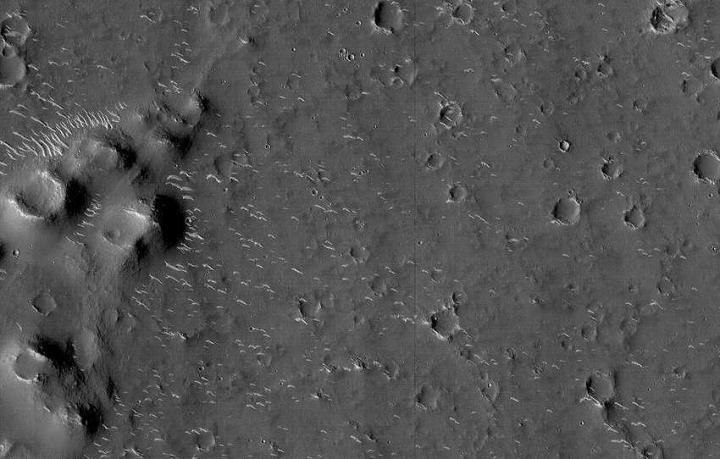
The Chinese automatic interplanetary station "Tianwen-1" has sent new black-and-white and color images from the orbit of Mars, announced the China National Space Agency on Thursday.
Black and white images were taken from an altitude of 330-350 km and a resolution of 0.7 m. There are craters, mountain ranges and dunes are visible on them. According to the message, the diameter of the largest of the craters recorded in the image reaches about 620 m. The color image shows the northern polar circle of the planet.
Tianwen-1 was launched on July 23, 2020 with a Changzheng-5 launch vehicle from the Wenchang Cosmodrome, located on the Island of Hainan. On February 10, it reached an elliptical orbit, and on February 24, it entered the reference orbit of Mars.
The probe is expected to make a soft landing in the southern part of the Utopia Plain in May-June. It is assumed that in this part of the planet, groundwater could come to the surface. The rover will study the soil, ionosphere and climate.
Quelle: TASS
+++
China's Tianwen-1 probe to land on Mars in May or June
China's Mars probe Tianwen-1 is traveling at a speed of 4.8 km per second in the Mars orbit, and is expected to land on the red planet in May or June, a senior space expert said on Thursday.
The probe is functioning normally and has sent home China's first high-definition images of Mars, which contain a large quantity of scientific information, said Bao Weimin, director of the Committee of Science and Technology under the China Aerospace Science and Technology Corporation.
The probe will survey the topography of the pre-selected landing area and conduct weather observation along the flight routes to avoid dust when landing on Mars, said Bao, who is also a member of the 13th National Committee of the Chinese People's Political Consultative Conference, the country's top political advisory body.
Nearly 50 Mars missions have been launched globally, but approximately two-thirds have failed, said Bao, adding that although China's Mars exploration began late, the probe is designed to be highly efficient and innovative, aiming to complete orbiting, landing and roving operations in one mission. Enditem
Quelle: Xinhua
+++
China releases high-resolution Mars images from Tianwen-1 probe
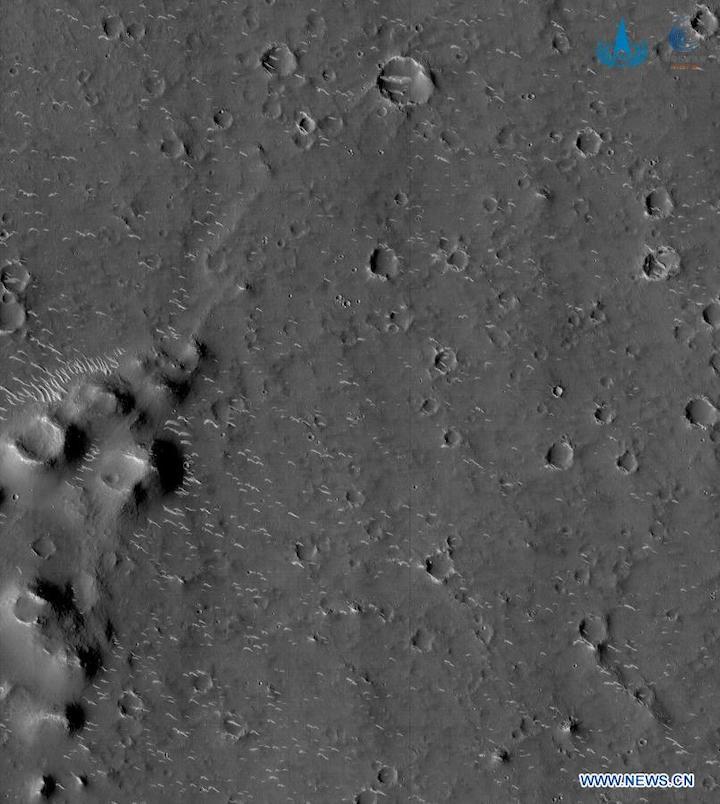
Photo released on March 4, 2021 by the China National Space Administration (CNSA) shows a high-resolution image of Mars captured by the country's Tianwen-1 probe. The China National Space Administration (CNSA) on Thursday published high-resolution images of Mars captured by the country's Tianwen-1 probe. These images include two panchromatic images and one color image, said the CNSA. (CNSA/Handout via Xinhua)
The China National Space Administration (CNSA) on Thursday published high-resolution images of Mars captured by the country's Tianwen-1 probe.
These images include two panchromatic images and one color image, said the CNSA.
The panchromatic images were taken by the high-resolution camera of Tianwen-1 at a distance of 330 to 350 km above the surface of Mars, with a resolution of about 0.7 meters.
In the images, Martian landforms such as small craters, mountain ridges and dunes are clearly visible. It is estimated that the diameter of the largest impact crater in the images is around 620 meters.
The color image is of the red planet's North Pole region taken by the medium-resolution camera, the CNSA said.
The high-resolution camera, medium-resolution camera, spectrometer and other scientific apparatus onboard the orbiter were switched on successively to collect data.
The medium-resolution camera is capable of both automatic exposure and remote-control exposure, enabling it to map remote-sensing images of the whole globe of Mars and to survey the planet's topography.
China launched Tianwen-1 on July 23, 2020. The spacecraft, consisting of an orbiter, a lander and a rover, entered the parking orbit around Mars after performing an orbital maneuver on Feb. 24.
Tianwen-1 probe has been conducting scientific surveys since Feb. 26. Enditem
Quelle: Xinhua

